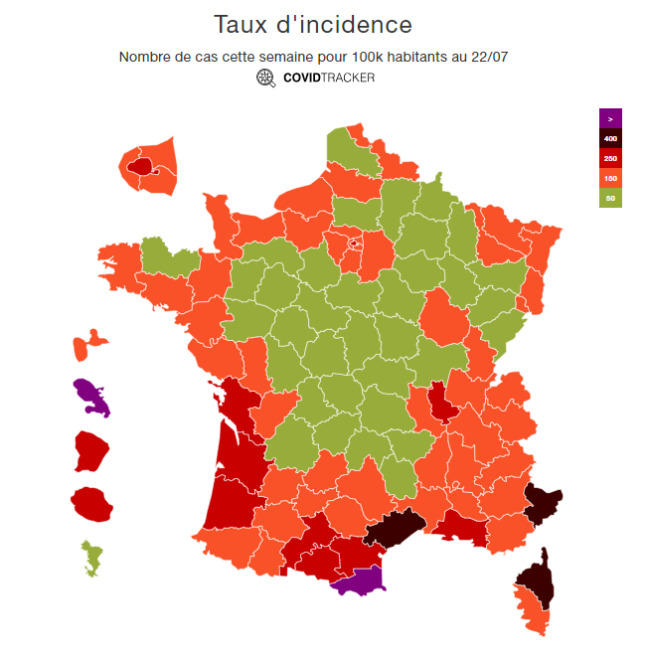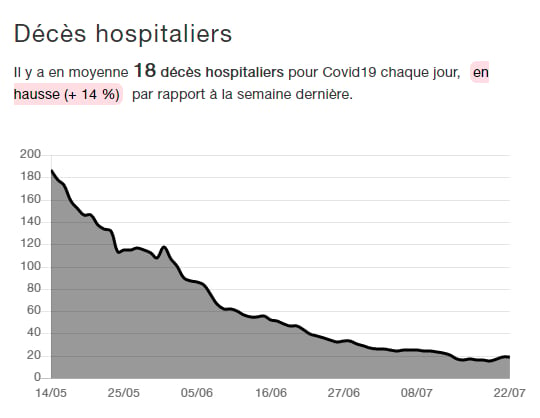“The Delta variant is the majority one, it is more contagious,” he said.
A day earlier, Health Minister Olivier Véran had told MPs that total cases had increased 150 percent in a week because of the fast-spreading variant. The rise, he said, was ‘unprecedented’.
The French government has rolled out the health passport to venues including cinemas and tourist sites and a bill is passing through parliament to extend this to cafés, bars, shopping centres and long-distance travel, as well as making vaccines compulsory for health workers.
READ ALSO When, where and why do you need a health passport in France?
Meanwhile on a local level, many authorities are reinstating compulsory face masks in the street and in some areas bars and restaurants are closing early.
Rising case numbers
If the 18,000 new cases number mentioned in Parliament on Tuesday sounds bad enough, the figures are continuing to rise.
France recorded 21,539 new Covid-19 cases on Wednesday, July 21st – a figure that Health Minister Olivier Véran said showed the “gravity” of the health crisis. He warned that models showed infection numbers would peak at the end of the summer, at levels that could overload hospitals. A further 21,909 cases were reported the following day.
This graph below, from le Parisien journalist Nicolas Berrod, shows the steep rise of recent days.
• 22 485 personnes ont été testées positives lundi, soit plus de 10 000 chaque jour en moyenne (+133% en une semaine, comprenant un jour férié).
• Près de 85% des cas positifs criblés sont des suspicions de variant Delta (mutation L452R détectée lors du criblage).#Covid19 pic.twitter.com/hangriu3Zg
— Nicolas Berrod (@nicolasberrod) July 23, 2021
Cases have soared by 140 percent this week, as the healthcare bill passes through the French parliament.
Incidence rate
The current national positivity rate, according to the Covidtracker website run by French data scientist Guillaume Rozier, is at 2.99 percent and the R-rate is at 1.68, meaning that the virus is spreading again, rather than being in retreat as it was when that figure was below 1.
The national number of cases per 100,000 people currently stands at 108 – but there are massive local differences, as this map shows.

In the south west département of Pyrénées-Orientales, for example, the number of cases per 100,000 currently stands at 449. In the Alpes-Maritimes – which includes the city of Nice – it has jumped to 255 – while in the central Nièvre département it is still as low as 15.
ALSO READ: Tourist areas bear brunt of France’s spike in Covid-19 cases
Hospital admissions
But with almost half the French population now fully vaccinated, how do increasing case numbers affect hospitals?
The number of people hospitalised and in intensive care has been falling for several weeks at the national level. But the sudden and significant rise in infections has health professionals fearing the worst.
There is usually a time lag of two to three weeks between a rise in cases and a rise in hospital numbers.
Between June 1st and June 30th, the number of people hospitalised almost halved from 16,088 to 8,451. Between July 1st and July 22nd, hospitalisations dropped from 8,232 to 6,832.
The same is true for patients in intensive care. Between June 1st and June 30th, the number of patients in intensive care fell from 2,825 to 1,204.
On July 1st, 1,162 ICU beds were occupied, falling to 868 on July 22nd.
But, what’s worrying medical staff is the fact that new admissions to hospitals and intensive care units are starting to rise again. On average, 200 new people are entering hospital every day, according to official figures, compared to 113 at the beginning of July.
The same is true for critical care. After falling until July 11th, the average number of new admissions to intensive care stagnated before rising again in the last few days: from about 20 new admissions at the beginning of the month to about 40 this week.
According to Véran, 96 percent of people who end up with the most serious forms of Covid are not fully vacinated.
Deaths
Covidtracker revealed that 18 deaths in hospital were reported on Wednesday, July 22nd – a 14 percent increase on the previous week.
While increases in low numbers appear disproportionately higher when listed as a percentage, Covidtracker also demonstrates that the number of deaths was falling much more quickly at the end of June, and has stagnated in recent days.

Vaccinations
What might mitigate against hospitalisations and deaths is the number of people who are now vaccinated against Covid-19.
Castex has set a new target for vaccinations – 50 million by the end of August.
Objectif : 50 millions de Français vaccinés à la fin du mois d'août.
➜ https://t.co/sGpUtk5csy— Jean Castex (@JeanCASTEX) July 21, 2021
And the Health Ministry’s figures show that more than 39 million people in France have already had at least one dose of vaccine – with more than 32 million fully inoculated.
#Vaccination #COVID19 | Au 22 juillet :
✔39 028 057 personnes ont reçu une 1ère injection
✔32 280 960 personnes ont un schéma vaccinal complet
✅Pour la 2e journée consécutive, plus de 800 000 injections ont été réalisées en 24h— Ministère des Solidarités et de la Santé (@Sante_Gouv) July 22, 2021
56% de la population française a reçu au moins une dose de vaccin, 45% est totalement vaccinée. pic.twitter.com/whnuMbALbf
— GRZ (@GuillaumeRozier) July 20, 2021
This simple graphic (above) in the same thread, however, shows there is some way to go before ‘herd immunity’ levels are achieved
The numbers are going up. The average for the three days to July 20th showed an average of 238,000 people had attended vaccine appointments, compared to the low of 160,000 a day at the beginning of the month.
Les données des 3 derniers jours viennent d’être publiées. Les primo-injections sont toujours en hausse. On en réalise 238 000 chaque jour en moyenne, contre 160 000 environ au creux (début juillet). pic.twitter.com/qa3EcM95Xp
— GRZ (@GuillaumeRozier) July 20, 2021
Some of the increase can be put down to President Emmanuel Macron’s address on July 12th, when he announced plans to extend the health pass. An immediate and sharp rise in bookings followed his announcement – and over 300,000 appointments have been made every day during the week beginning Monday, July 19th.
Passé l'énorme engouement des premières heure post allocution d'E. Macron, le rythme reste à un rythme élevé : un peu plus de 300 000 rendez-vous pour une première injection ont été pris chaque jour sur Doctolib depuis lundi, les 2 tiers par des moins de 40 ans. #Covid19
1/ ⤵️ pic.twitter.com/iz5xDzzSrP— Nicolas Berrod (@nicolasberrod) July 23, 2021
On the downside, the increase in vaccine demand, after the early summer slump does mean the gap between appointment and first jab has risen to more than 11 days – more than twice the waiting time before Macron spoke.
What happens next?
Almost six million French people made an appointment to receive a first vaccine dose in the nine days since President Emmanuel Macron’s speech announcing the new measures. Most of those will be fully vaccinated by the end of August, taking the total number a good chunk of the way to the government’s 50 million target.
Assuming the health pass extension bill is passed, healthcare workers have until September 15th to be vaccinated, while plans have been mooted to take vaccination services into colleges and lycees early in the new school year to catch unvaccinated school children aged 12 and over as soon as possible.
But not everyone is sure that a return to normality will be rapid, even with vaccines. Noted immunologist and government Covid adviser Jean-François Delfraissy has warned that new variants could slow things down.
“The return to normal life may be 2022, or 2023.[… ] We will win, but I think we have entered into something longer,” he said.
Jean-François Delfraissy : "Le retour à la vie normale, c'est peut-être 2022, ou 2023. […] Nous gagnerons mais je pense qu'on est rentré dans quelque chose sur la longueur." Il fait notamment référence à l'émergence attendue de nouveaux variants. #Covid19 #BFM
— Nicolas Berrod (@nicolasberrod) July 23, 2021




 Please whitelist us to continue reading.
Please whitelist us to continue reading.
A good article, very fair and balanced
But looking across to the UK with the same variant – there has been so significant rise in hospital inpatients or the death rate
By now most of France’s most vulnerable (the elderly and the disabled) have been double vaccinated and it was mainly in these groups that the world has seen the highest death rates.
Let us hope that France hospital and death rates follow the UK figures and those figures remain low.
ASS for the bill – what’s the point? the vaccine does not stop people catching or transmitting covid – the only way to keep a hospital or care home free is daily testing – same goes for any place where the public meets – seems to me to be a case of using a sledgehammer to crack a nut